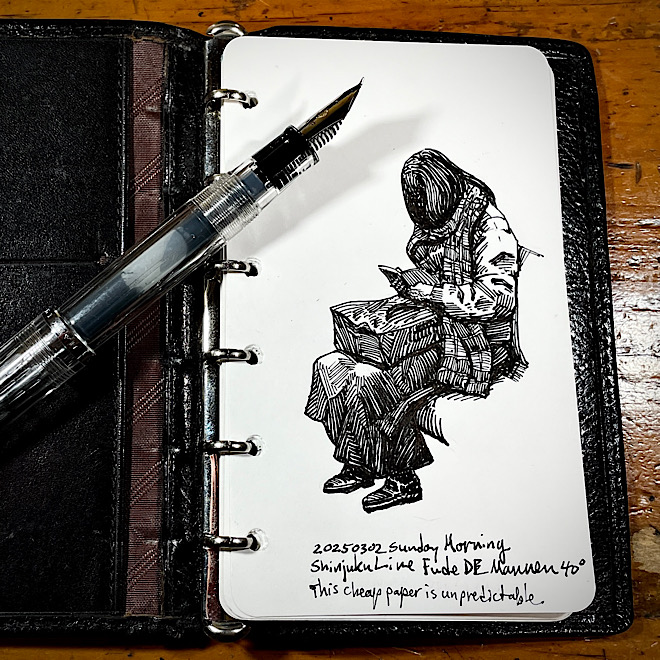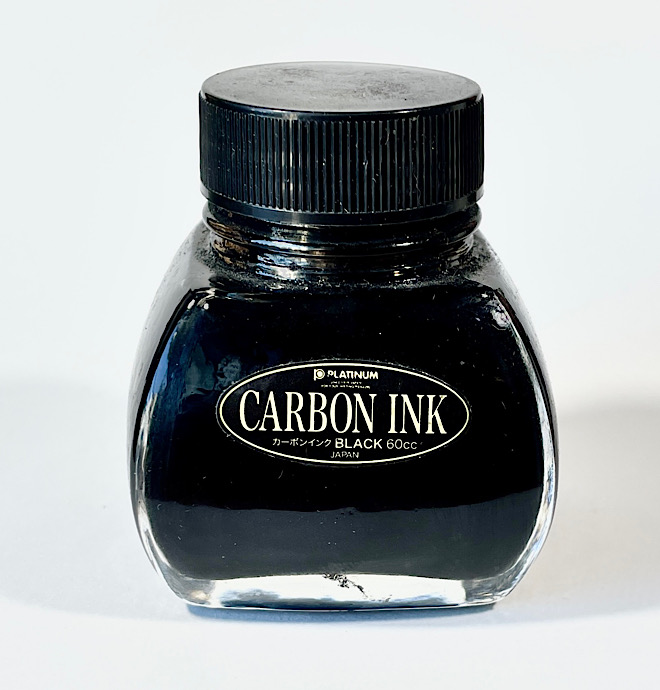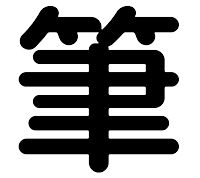The Fude DE Mannen
A Bent-nib Fountain Pen for Artists
If you search for Urban Sketching on the web and on YouTube, you will eventually come across fountain pens that have bent nibs.
These special pens are generally called fude nib pens, and most of them come from China.
See my article Enter the Chinese bent nib fountain pen for more on this.
The first fude nib pen was the Fude DE Mannen made by the Sailor Pen Company in Japan.
It was first released on November 20, 1995.1
Fude (foo-deh) is the Japanese word for brush.
But these fountain pens are nothing like a brush; the nib is made of metal and not flexible at all.
The misconception that a fude nib fountain pen will somehow produce flowing brush lines has led to much disappointment.
So, what's the connection between the Fude DE Mannen and real brushes?
Historically, writing in Japan was always done with a brush that was held upright and perpendicular to the paper.
Then the fountain pen arrived in Japan around the late 1800s and was seen as an alternative to the brush.
The Japanese word for fountain pen (man nen hitsu) literally means ten thousand year brush.
But when people in Japan first tried to write with a fountain pen, they held the pen vertically like a brush.
This resulted in a dry scratchy line with the sharp point of the nib catching and tearing holes in the Japanese washi paper.
The fountain pen was also much shorter than the brush and felt awkward in the hand.
Of course, the Japanese quickly adapted to this new writing instrument and wrote with the pen at a lower angle.
But there are times such as at the New Year and weddings when a lot of Japanese people want go back to the traditional writing style.
Ritual is important in Japan, and how something is done can be as important as the task itself.
The Fude DE Mannen lets people hold a fountain pen in the traditional upright position, but the tip of the nib will touch the paper at a lower angle as if it were a regular fountain pen.
It's an ingenious solution.
People could write kanji characters in the traditional way and still enjoy the benefits of a fountain pen.
Japanese children are taught how to write with a brush, but a fountain pen is still easier and more convenient for those who have not written with a brush since their school days.
The Fude DE Mannen also has a long barrel so it handles more like a brush.
Of course, the kanji characters will still look like they were written with a fountain pen and not a brush.
The tip is bent at a 55 degree angle so that even if you hold the pen vertically at a 90 degree angle, the nib will come in contact with the surface of the paper at a much lower angle and deliver ink smoothly.
Sailor advertises this feature right on the package.

The only thing these pens have in common with brushes is the fact that you hold them in an upright position like a brush.
 A lot of people write with the brush at a lower angle which is not perpendicular to the paper. A lot of people write with the brush at a lower angle which is not perpendicular to the paper.
So Sailor also produced a second version of this pen with the tip bent at 40 degrees instead of 55 degrees.
On the 40 degree version packages they changed the wording to say:
Recommended for people who write with their pen at a low angle
Holding the 55 degree nib perpendicular to the paper (90 degrees) will have the nib come in contact with the paper at a 35 degree angle.
To get the same 35 degree angle of contact with the 40 degree nib, you would hold the pen at 75 degrees.
Regardless of the angle of the nib bend, one unintentional benefit of this unique nib is the different line widths you can get by varying the angle of the pen itself.

You get the thinnest line from the reverse side of the nib.
Then you get a few medium line widths from the regular side of the nib as you lower the angle.
The portion of the nib beyond the bend is actually a flat plane and not curved, but you can get a few line widths because ink will be drawn out of the nib even if the nib is not actually touching the paper.
Finally you get the broadest line when the entire surface of the nib is in full contact with the paper.
As the photo shows, you can get the same range of stroke widths from either the 55 degree nib or the 40 degree nib, depending on the angle you hold the pen itself.
As with most fountain pens, you can also quickly lift the nib off the paper to get a short tapered line.
The ability to get different lines widths by varying the angle of the pen is also mentioned on the package.
The hard metal nib won't vary the line width like a soft brush (unless you do some incredible acrobatics), but a single pen that gets variety of stoke widths can be extremely valuable when drawing on location.
When artists discovered the Fude DE Mannen it became a popular sketching tool, especially with urban sketchers.
I'm not much of an urban sketcher, but I do love to draw people on the subway, and the Fude DE Mannen makes it even more gratifying.
The sketches above and below were done on the subway with a 40 degree Fude DE Mannen.

I did not exploit the full range of possible stroke widths I could get with this pen because these are small sketches on index cards.

The ones below were done on postcards, and it took many sketch attempts before I could draw in the same style at this slightly larger size.

There is a relationship between the size of the sketch and the size of the fude nib. I used the broad part of the nib more and the tip of the nib less at postcard size.
I wrote more about my transition to postcard size sketching with the Fude DE Mannen in my article, Postcard Sketching and A6 Ring Binders.

It continues to amaze me that I can get all these stroke widths from just one pen.
At first it might take a while to the enjoy the full benefits of this nib, but eventually you will find yourself instinctively rotating the pen and changing the angle as you draw.
I have written more about Fude DE Mannen pens and how they influence my evolving style in my article on Franklin Booth.
Some artists may find the barrel of the Fude DE Mannen a bit too long, especially if they try to post the cap on the barrel.
This pen is also available as a shorter Profit Junior model with a clip. It is light-weight and well balanced when the cap is posted. with a clip. It is light-weight and well balanced when the cap is posted.
The Fude DE Mannen also comes in limited editions with special colors like this Lecoule model with a clear barrel and yellow cap that I got from the online Sailor Shop in Japan.
I really like how the clear barrel lets me see how much ink is left in the cartridge or converter.
It also lets me know if the ink has actually moved down to the front of the cartridge or converter. Sometimes the ink doesn't move down and needs a little shake.
So I wanted a few more with clear barrels, but there are only a few limited edition models offered at any given time.
Instead of getting two more identical limited edition models, I bought some Sailor Profit Junior pens that had clear barrels with regular nibs, and two long Fude DE Mannen pens.
I swapped the nibs and had two new Fude DE Mannen demonstrator pens (called skeleton pens in Japanese).
The top pen has silver color trim which didn't match the gold plated fude nib. But some metal polish (Simichrome) and a few cotton swabs quickly removed the gold color and gave me a nice silver color stainless steel nib.
The other pen is a limited edition translucent black Profit Junior called Kuro-gane, and it's very rare now. I was fortunate enough to spot one in a pen shop.
(Just pinch out the photo to see these pens in detail.)
Now I have three Fude DE Mannen pens with clear barrels.
Still, one thing the long model has in its favor is the iconic design which is recognised all over the world.
The length makes it appear more slim, but all the Fude DE Mannen barrels I have tried (original long model, Profit Junior and Lecoule) are actually the same diameter and even interchangeable.
The long barrel has enough room to carry a spare cartridge, which can be a life saver when you are sketching on location.
But that spare cartridge rattles in the barrel, which was distracting.
Then I found an incredibly simple and effective solution:
Just take a spring from a click-type (knock) ballpoint pen and drop it into the barrel before you store a cartridge. No more rattle!
These pens come with two cartridges of Sailor water-soluble black ink which is very black and great for sketching, but you can also use Sailor Kiwaguro pigment ink cartridges.
Kiwaguro ink is supposed to be waterproof, but I have not been able to use watercolor on top of Kiwaguro lines because it smudges with water even after the ink has dried for a day.
But Kiwaguro ink is wonderful in at least two other ways. First, it is consistently black, because it is a pigment ink and not dye-based.
I discovered the second advantage by accident. I had been drawing on cheap index cards with regular Sailor ink when it started to feather slightly. This is really annoying when I am trying to draw fine hatch lines. When I switched to Kiwaguro ink, it didn't feather at all.
However, there is one more caveat concerning Kiwaguro ink. If you keep your sketches in a sketchbook, the ink will transfer to the facing page.
It doesn't feather on cheap paper like regular dye ink because it doesn't penetrate into the paper, but that excess ink layer on the surface can lift off and smudge.
I had been storing my ink sketches in a ring binder when I discovered this problem. I was able to erase much of the transferred pigment, but I went back to Sailor regular black ink after that.
If you want to use ink from other companies, you can get a Sailor converter . .
You can also fill an empty Sailor cartridge with a syringe.
A lot of sketch artists use waterproof Platinum waterproof Carbon Ink so they can go over the ink lines with watercolor. Carbon ink can dry out in some fountain pens, but I have had no problems with the Fude DE Mannens; they apparently have airtight caps. so they can go over the ink lines with watercolor. Carbon ink can dry out in some fountain pens, but I have had no problems with the Fude DE Mannens; they apparently have airtight caps.

I love Carbon ink but it can feather slightly on some of the cheap papers I use. So I use Kiwaguro ink in my Fude DE Mannens for regular sketching, and Carbon ink in the pens dedicated to ink and watercolor on nicer paper.
If you ever experience trouble with dry ink clogging a Fude DE Mannen, it is possible to take the nib section apart and thoroughly clean it along with the nib.
Just give the nib and ink feed a good tug, and they will come out of the nib section. You may need a small sheet of rubber for friction to get a good grip.
If you use regular Sailor ink in your pen, Sailor says that you only need to clean it once a year. That is good news for people who hate to clean their fountain pens.
By the way, now that I have accumulated so many Fude DE Mannen pens I can say with certainty that some write smoothly and some are a bit scratchy.
I have read articles and seen videos where it was claimed that all Fude DE Mannen pens are scratchy or that one model or nib angle is more scratchy than the other. Ideally all the nibs should write smoothly, but there is a difference between each individual nib which I can only chalk up to quality control issues.
My limited edition Lecoule wrote very smoothly right out of the box, but your mileage may vary with the mass produced models.
A little nib smoothing may be required, and you may need to do a web search to see how it's done. Don't ask me; I've ruined more than a few nibs this way.
Which angle is best for Sketching?
As mentioned above, the Sailor Fude DE Mannen comes in two nib angles, one bent at 55 degrees and the other bent at 40 degrees.
So, which angle is right for you?
Generally speaking, the 55 degree nib lets you get broad lines quicker while the 40 degree nib lets you get fine lines quicker.
In other words, when you hold your pen at your natural writing angle, the 55 degree pen will give broader lines while the 40 degree pen will give finer lines.
To get fine lines with the 55 degree nib, you have to put in more effort to raise the barrel to a high angle.
To get broad lines with the 40 degree nib, you have to put in more effort to bring the barrel down to a low angle.
If you lean towards fat lines for most of the sketch as you would do in a large sketch, then the 55 degree pen is recommended.
And if you lean towards finer lines or sketch on smaller paper, then 40 degrees is recommended.
I rarely sketch larger than postcard size these days, so I prefer the 40 degree pen.
But as the photo shows, both pens will get the same range of line widths.
The name explained
Fude DE Mannen is a crazy name.
And it doesn't help that it's all in Japanese except for the word DE which has led some folks to simply call it the DE pen.
So let me untangle that crazy name here:
The Japanese word for fountain pen is man nen hitsu (pronounced mahn-nen-hee-tsoo).
It means ten thousand year brush, or the brush that ain't gonna wear out any time soon.
That last kanji for brush can be read two ways:

- hitsu (pronounced hee-tsoo)
- fude (pronounced foo-deh)
Sailor replaced these kanji with hiragana (simpler Japanese characters), rearranged them, and inserted DE to come up with the name fude de man nen (pronounced foo-deh-deh-mahn-nen).
De is a particle for by means of and Sailor put DE in capital letters for a slightly jarring effect (maybe because it came late to the party).
So the name tells us that this is a way to write like a brush by using a fountain pen.
The next few pages will be about developments which kind of bumped fude nib pens off the radar for a while in my life, but these pens will come back and become my main sketching tool several months later. I write about this a few pages later in Enter the Chinese bent nib fountain pen.
Footnotes:
1 A note concerning the origins of the fude nib pen:
I have heard a story that the fude nib pen was invented in 1949 by Sailor's legendary nib designer the late Nobuyoshi Nagahara.
However, he would have been a teenager and an apprentice at the time.
I met Mr. Nagahara in 2001 at a Sailor Pen clinic in Tokyo, and I don't doubt that he could have been the inventor of the fude nib pen, but not in 1949.
I have also heard that Sailor released the world's first fude nib pen in 1972.
But that was actually a soft tip brush pen (fude pen) and not a fountain pen, and you can see a photo of this brush pen on the Sailor website.
People often confuse fude pens with fude nib pens.
However, I do recall that I bought a bent-nib fountain pen at a stationery shop in Tokyo in the early 1990's before the Fude DE Mannen was released.
This was a slim plastic pen with a bright green barrel.
It had a metal nib that was bent upward, and I had no idea how to use it.
The nib was made of thin metal and soon broke, so I threw the pen away many years ago.
What this implies is that no matter what is claimed about the origins of the fude nib pen, I can personally attest to the fact that I owned a bent-nib fountain pen before the Fude DE Mannen was released.
Back to the article
The illustrations on this page of the old woman and the urban sketcher were rendered by AI (Microsoft Bing's Copilot) and modified by me.
AI might take over illustration jobs in the future, but it can never take away sketching as a gratifying hobby.
Note about Amazon links: If you click on a link and buy something at Amazon, a few pennies per dollar goes into my Amazon account, so instead of letting Amazon keep it all, you can pry a few pennies from their fingers make them share it with me. Any other vendor links I may put on this website are just for your convenience.
|